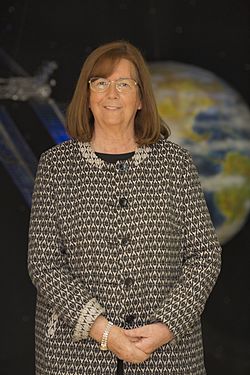María Teresa Ruiz facts for kids
María Teresa Ruiz (born September 24, 1946) is a famous Chilean astronomer. She made history by being the first woman to win Chile's National Prize for Exact Sciences. She was also the first woman to earn a PhD in astrophysics from Princeton University. Later, she became the first woman president of the Chilean Academy of Sciences. She is also well-known for finding a special type of star called a brown dwarf, which she named Kelu-1.
In 2018, María Teresa Ruiz was recognized as one of the top 10 most powerful and important women in Chile. This was because of all her amazing contributions to science.
She has also written two books about space and stars. These books are called Desde Chile un cielo estrellado: lecturas para fascinarse con la astronomía (2013) and Hijos de las Estrellas (2017).
Contents
Early Life and Studies
María Teresa Ruiz was born in Santiago de Chile in 1946. In 1966, she started studying chemical engineering at the University of Chile. However, she discovered her true passion during an astronomy summer school.
She then changed her studies to the new astronomy program at the University of Chile. She was the very first person to graduate from this program in 1971.
Career and Discoveries
In 1975, María Teresa Ruiz finished her advanced studies with Martin Schwarzschild. She became the first woman to get a PhD in astrophysics from Princeton University.
In 1997, she made history again by becoming the first woman in Chile to receive the country's National Prize for Exact Sciences. Before this, she worked as a researcher at the Astronomical Observatory of Trieste in Italy. She also spent two years working at the Institute of Astronomy at the UNAM in Mexico.
Finding Kelu-1
In 1997, María Teresa Ruiz discovered Kelu-1. This is a system made of two brown dwarfs. Brown dwarfs are like "failed stars" because they are not big enough to start burning like regular stars. Kelu-1 was also one of the first brown dwarfs found floating freely in space.
This system is located in the Hydra constellation. It is about 61 light years away from Earth. Finding Kelu-1 was a big surprise for Ruiz. With all her experience, she usually recognized different space objects easily. But this time, the light spectrum she saw was very different and new.
She was able to find lithium in this star. She also noticed it was extremely red, which is a common feature of brown dwarfs. These two clues helped her confirm that this object was a brown dwarf. It was one of the first ones found floating on its own.
The name Kelu comes from the Mapuche language. It means "red," which refers to the color of the star.
Important Roles
María Teresa Ruiz has held many important positions throughout her career:
- From 1975 to 1976, she was a researcher at the Astronomical Observatory of Trieste in Italy.
- From 1977 to 1978, she was a visiting researcher at the Institute of Astronomy of the UNAM.
- In 1978, she visited the Goddard Institute for Space Studies (GISS) at NASA as a researcher.
- From 1979 to 1989, she taught in the Department of Astronomy at Universidad de Chile. She started as an associate professor and later became a permanent professor.
- Since 1992, she has been a member of the Association of Universities for Research in Astronomy (AURA). She represents the Universidad de Chile there.
- In 2001, she became the chairwoman of the Astronomy Department, a role she held until 2005.
- In 2015, she was chosen to be the president of the Chilean Academy of Science.
- As of 2019, she is a Professor at Universidad de Chile Department of Astronomy (DAS). She is also the Director of the Center for Excellence in Astrophysics and Associated Technologies (CATA).
Books Written
María Teresa Ruiz has written books to share her love for astronomy:
- Desde Chile un cielo estrellado: lecturas para fascinarse con la astronomía (2013)
- Hijos de las estrellas (2017)
Awards and Honors
María Teresa Ruiz has received many awards for her work:
- Carnegie-Chile Fellowship, 1971–1975
- MacArthur Foundation-AAAS Starter Grant, 1993
- Presidential Chair in Science, 1996
- Chancellor's Medal, University of Chile, 1996
- National Prize for Exact Sciences, 1997
- Chancellor's Medal, University of Chile, 1998
- Fellow of the Academy of Sciences, 1998
- Labarca Merit Award, 2000
- Guggenheim Scholarship, 2001
- L'Oréal-UNESCO Awards for Women in Science, 2017
- Recognized as one of the BBC's 100 women of 2017
- Legion of Honour, Chevalier class (Knight)
Personal Life
María Teresa Ruiz enjoys embroidery as a hobby. She is very skilled and can embroider detailed portraits of people and families. She started this hobby when she went to study abroad. She wanted to keep her family close, so she embroidered a family portrait to remember them.
She is married to Fernando Lund, who is also a Chilean scientist and professor. In 1980, they had a son named Camilo, who is now a civil engineer.
See also
 In Spanish: María Teresa Ruiz para niños
In Spanish: María Teresa Ruiz para niños


